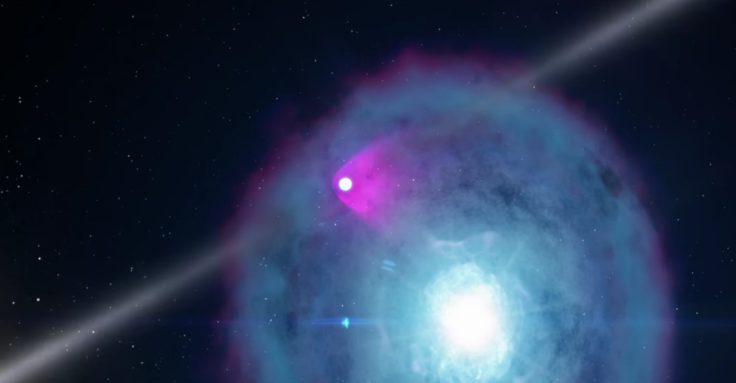Close Encounter Of A Pulsar And Star Expected To Trigger A 'Cosmic Light Show'

In only three years from now, astronomers might be able to witness a rare celestial firework display. In the early months of 2018, NASA hopes to get a glimpse of a pulsar, comparable in size to a city on Earth, plunging through the cloud of gas and dust surrounding one of the brightest stars in our galaxy, triggering a “cosmic light show.”
Pulsars are rotating neutron stars, which are immensely dense stars created as a result of a massive star collapsing in on itself. As a pulsar rotates, it emits high-energy radiation, similar to a lighthouse casting beams of light. If this beam of high-energy radiation is pointed toward Earth, these high-energy pulses can be detected using radio and gamma ray telescopes.
The pulsar under observation here is J2032+4127. It is about 12 miles across, weighs almost twice as much as the sun, and is spinning seven times a second. This pulsar is locked in an elongated and eccentric orbit of about 25 years around a star named MT91 213, which is 15 times the mass of the sun and 10,000 times brighter.
“When we discovered this pulsar in 2009, we noticed that it was in the same direction as this massive star in the constellation Cygnus, but our initial measurements did not give any evidence that either star was a member of a binary system,” Paul Ray, an astrophysicist at the Naval Research Laboratory in Washington, said, in a statement released Thursday. “The only way to escape that conclusion was if the binary system had a very long orbital period, much longer than the longest known pulsar-massive star binary at the time.”
In 2018, the pulsar would be seen passing through the star’s surrounding disk -- a phenomenon that scientists hope would help them determine the massive star's gravity, magnetic field, stellar wind and disk properties.
“This forewarning of the energetic fireworks expected at closest approach in three years’ time allows us to prepare to study the system across the entire electromagnetic spectrum with the largest telescopes,” Ben Stappers, a professor of astrophysics at the University of Manchester, said in the statement.
© Copyright IBTimes 2024. All rights reserved.





















